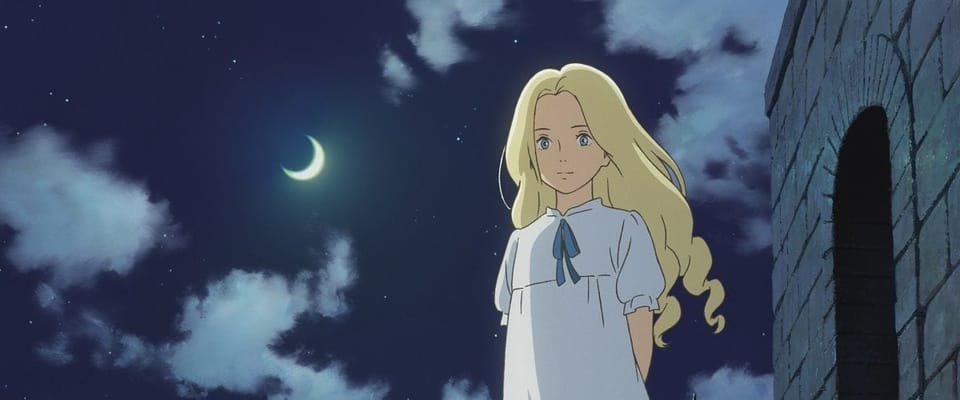When Marnie Was There (2014)

When Marnie Was There is a milestone not only for Studio Ghibli and its fans, but anyone who enjoys quality films that can be shared with the entire family. It is the second feature film by Hiromasa Yonebayashi (The Secret World of Arietty), and the last movie from Studio Ghibli before its indefinite hiatus from feature film making. Whilst it is not exactly ‘young’ in terms of its content, it touches on an important theme of life that viewers of all ages should find deeply moving.
It tells a story of love and friendship between two young girls, Anna and Marnie. Anna is a 12-year-old girl who finds herself outside ‘an invisible circle’ called humanity. She is intensely private, and her interactions with others are limited to the bare minimum. She hates her awkwardness, she hates the resulting alienation, and, most of all, she hates herself. One day, she suffers a severe asthma attack at school. A doctor recommends her mother to send Anna to the countryside in order to ease the stress arising from Anna’s social awkwardness. Anna stays with her uncle and aunt who live in a seaside village where she makes a fateful encounter with a mysterious foreign girl of her age, Marnie, whose friendship, for Anna, becomes her very reason to live. It is a wonderfully illustrated story of love, friendship, the importance of family ties, which are the keys for one's healing, and coming of age.
The above description fits just about every movie produced by Studio Ghibli. For example, Kiki’s Delivery Service is a coming-of-age story about a 13-year-old witch, who has to overcome her insecurities and confusions. Spirited Away’s Chihiro, Shizuku from Whisper of the Heart, Satsuki from My Neighbour Totoro, Taeko from Only Yesterday… all of these protagonists have to struggle with their obstacles to discover who they really are. Studio Ghibli has been consistently producing excellent coming-of-age stories, and Marnie seems to fit neatly into this tradition. Yet, remarkably, Yonebayashi achieves what Miyazaki and Takahata attained in a very different way. For this reason, Marnie cannot be simply appreciated as the ‘last feature movie’ from Studio Ghibli; it should be praised as a great film in its own right. So what makes Marnie a stand-out film, even compared to the best of Ghibli’s features?
In this film, Yonebayashi decides to tackle the real darkness in life without compromise. There are simply no other films from Studio Ghibli, or any family features, opens with such a sense of despair. The loneliness, the sense of unworthiness, and the resulting self-hatred Anna feels is expressed with a great urgency that it seems only a matter of time before Anna carries out her first suicide attempt. Anna’s departure to the remote village projects little excitement; instead, there is a sense of abandonment that cuts deep into her tender heart. Whilst Anna occupies herself with drawing, unlike in Miyazaki films, the art does not bring any life-saving magic to this protagonist. Unlike in Takahata films, not even the natural beauty of this remote land can console her soul. In short, Anna represents a dire condition of the human soul which is rarely explored by film directors except Ingmar Bergman, who did so with great regularity. Life is a mere mortal coil for Anna, and she has no reason to live. She is barely hanging on, simply because she has not yet considered the final exit to be an option for her.
Very few family films has ever been allowed to express such despair. It is a courageous decision Yonebayashi commits himself to, and it pays off; Marnie turns out to be one of the most emotionally authentic films I have ever seen. The way Anna is filmed excludes all sense of self-pity and indulgence. By looking at her face, we receive her message clearly: The world is a better place without me. Yonebayashi succeeds in making us feel her pain and taking it seriously. Only a few have ever achieved this feat in animated films. Takahata achieved this with The Tale of Princess Kaguya, as well as Robert Kondo and Daisuke Tsutsumi with their excellent short, The Dam Keeper. Still, Yonebayashi enjoys the distinction of telling a story of despair and redemption in a realistic setting of contemporary Japan. Given that juvenile suicide has been a grave problem in post-WWII Japan, and it is becoming a serious concern globally, this achievement is of particular importance.
It is only through the friendship of Marnie that Anna finds a reason to live. The story of Marnie is not a happy one either; she faces real darkness herself, yet she somehow manages to find joy in life. Whilst Marnie appears more like a standard Studio Ghibli character, that is, charming, brave, and full of life, the sadness and despair she feels is just as real as Anna’s. And because the darkness experienced by these characters are genuine, the final redemption brings a truly exhilarating catharsis.
One might think that the twist of fate Anna and Marnie share is a very unlikely story in real life. I must refrain from giving a full argument in support of this narrative; thus I simply state this for the time being: This story takes a particular path to show one universal truth about the indispensable nature of love in our lives, and the way this story is told is not only justified; it is the true strength of this great movie.
After the viewing, I’ve been left wondering when we will be able to see the next movie by Yonebayashi. If you know anyone who might know this young director, please pass on this reviewer’s words:
Please continue. You are too good to quit.